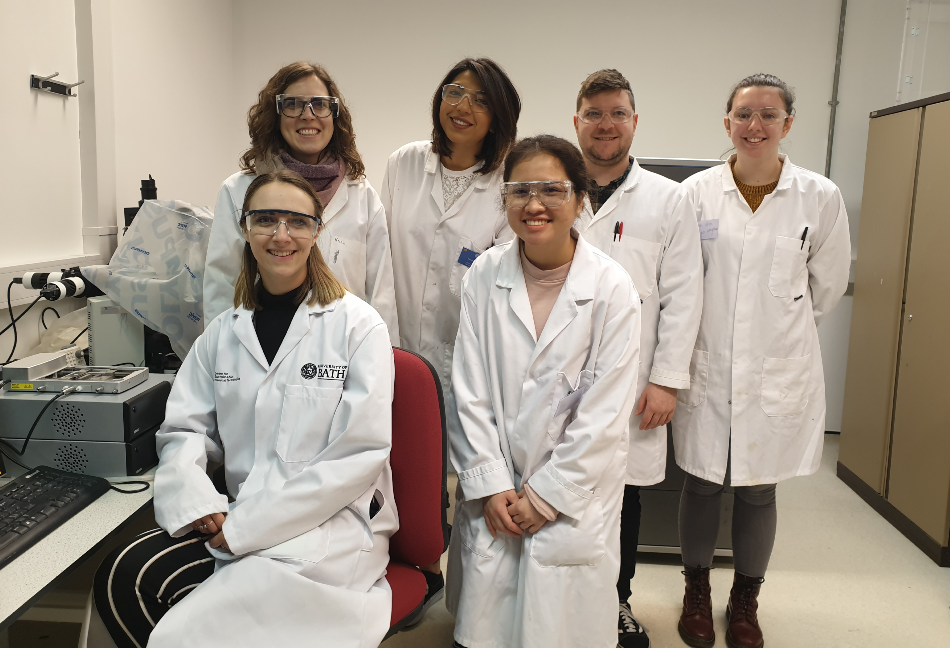Carbon nanotubes (CNTs) are cylinder-shaped nanoscale hollow tubes that are made up of one or more layers of carbon atoms. CNTs are chemically bonded with sp2 bonds like their building block graphene, which, together with their natural tendency to rope together via van der Waals forces, leads to ultra-high-strength and low weight properties.

Dr. Hannah Leese and team at The University of Bath
This, combined with their high thermal and electrical conductivity make CNTs a valuable material for a number of applications, from healthcare to energy harvesting and storage.
The unique one-dimensional (1D) structure provides CNTs with properties that expand their potential in a wide variety of nanotechnology applications1.
For instance, CNTs have been considered as potentially suitable materials for water filtration since their discovery in 1991, because of their smooth structure, low tortuosity (a measure of the geometric complexity of a porous medium) and the possibility of optimizing their diameter2.
CNTs may be classified as single-walled carbon nanotubes (SWCNTs) or multi-walled carbon nanotubes (MWCNTs), depending on the number of carbon atom layers present.
The length of an SWCNT usually ranges from ~0.1 µm to 20 µm, and its diameter can be between ~0.5 nm and 100 nm3, which gives these nanomaterials a high aspect ratio.
In addition to anisotropic (directionally dependent) properties, this ratio makes SWCNTs well suited to nanocomposite fiber applications4. SWCNTs also meet the requirement for ductile, high-performance fibers that maintain stiffness and high strength.
Measuring Nanomaterial Properties
Testing tensile properties is vital during the development of new nanostructured composite fibers.
Various techniques have been developed to synthesize supergrowth nanotubes (SG-CNTs), or ultra-long SWCNTs, which are the toughest and strongest reported nanotube-based fibers to date, and to subsequently incorporate them into structural and multifunctional polymer composites.
The high aspect ratio of SG-CNTs has a number of advantages, like higher electrical and thermal conductivity5. Yet, transferring the intrinsic properties of SWCNTs into real-world macroscopic materials is difficult, so research is focusing on incorporating SWCNTs into multifunctional and structural polymer composites successfully.
Furthermore, due to their high surface energy, SWCNTs usually form bundles that are electronically and mechanically inferior to the ideal individualized species.
At the University of Bath, recent studies have examined the utilization of chemically reduced nanotubes to overcome the challenge of SG-CNT individualization, and compared the utility of these fibers with standard SWCNTs by examining the influence of SWCNT length on mechanical behavior, via the synthesis of SWCNT/poly(vinyl chloride) (PVC) composite fibers6.
The first response of SG-CNTs was similar to commercial SWCNTs, and whilst retaining high strength, it showed an extended plastic elongation after yield.
When compared with the toughest short-SWCNT reinforced with PVC composite fiber tested (Figure 1), the heightened plastic strain led to a substantial enhancement in toughness – an increase of 2.4 times. These results supply more evidence that high aspect ratio SWCNTs are advantageous for mechanical applications.

Figure 1. (a) Typical stress-strain curves illustrating the different mechanical responses, (b) strength, (c) Young’s modulus, (d) strain-to-failure, (e) toughness. Measured using a TST350Tensile Stress Tester (Linkam Scientific Ltd, UK). Adapted from reference 6 in accordance with the Creative Commons Attribution 3.0 Unported Licence.
Tensile Testing Technology
These experiments make use of advanced imaging technology to visualize the mechanical properties of CNTs. Specialized temperature-controlled stages, like Linkam’s Modular Force Stage (MFS), can be integrated with optical microscopy instruments in order to gather information about a nanomaterial’s performance in a given environment.
This allows researchers to correlate physical characteristics measured by the temperature-controlled device with the optical information. Temperature-controlled stages allow tensile measurements of very fine fibers like CNTs, with superior sensitivity compared with traditional large tensiometers.
In addition to temperature, to simulate the in situ environment that the material will be subject to when in use and permit the observation of property changes, some stages can control nitrogen atmosphere and humidity.
Continuing Diverse Research
In addition to optical microscopy, temperature-controlled devices may be utilized with transmitted or reflected illumination, and other methods including X-ray, Raman and Fourier transform infrared (FT-IR) spectroscopy.
By utilizing such devices, researchers at the University of Bath are breaking new ground in point-of-care (POC) diagnostics for nanomedicine whilst enhancing their understanding of the mechanical properties of novel materials, like graphene oxide fibers.
References and Further Reading
- Golbabaei F, Ebrahimi A, Shirkhanloo H, Koohpaei A and Faghihi-Zarandi A. Single-Walled Carbon Nanotubes (SWCNTs), as a Novel Sorbent for Determination of Mercury in Air, Global Journal of Health Science, 2016, 8(7): 273-280.
- Whitby M and Quirke N. Fluid flow in carbon nanotubes and nanopipes, Nat. Nanotechnol, 2007, 2: 87–94.
- Govada L, Leese HS, Saridakis E, Kassen S, Chain B, Khurshid S, Menzel R, Hu S, Shaffer MSP and Chayen NE. Exploring Carbon Nanomaterial Diversity for Nucleation of Protein Crystals, Scientific Reports, 6:20053.
- Jun Lee W, Clancy AJ, Fernández-Toribio JC, Anthony DB, White ER, Solano E, Leese HS, Vilatela JJ and Shaffer MSP. Interfacially-grafted single wall carbon nanotube / poly (vinyl alcohol) composite fibers, Carbon, 2019, 146: 162-171.
- Li J, Ma PC, Chow WS, To CK, Tang BZ and Kim JK. Correlations between percolation threshold, dispersion state, and aspect ratio of carbon nanotubes. Adv. Funct. Mater., 2007, 17, 3207–3215.
- Clancy AJ, Anthony DB, Fisher SJ, Leese HS, Roberts CS and Schaffer MSP. Reductive dissolution of supergrowth carbon nanotubes for tougher nanocomposites by reactive coagulation spinning, Nanoscale, 2017, 9: 8764-8773.
Acknowledgments
- Produced from materials originally authored by Dr Hannah Leese, PhD, University of Bath and Duncan Stacey, Sales and Marketing Director from Linkam Scientific Instruments.

This information has been sourced, reviewed and adapted from materials provided by Linkam Scientific Instruments.
For more information on this source, please visit Linkam Scientific Instruments.